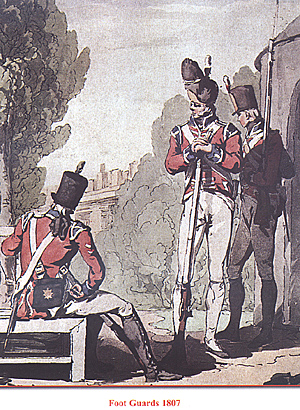The Organisation and Service
of the British 1st Foot Guards
1793 - 1809
by John Cook, UK
| |
There were three established permanent battalions in 1st Foot Guards. The ‘4th’ battalion was initially formed in March 1793 from 4 grenadier companies of the guards brigade sent to Holland. It was not part of the establishment and was formed for service. It is also called the ‘grenadier battalion’ (Hamilton). Furthermore, the battalion was not formed exclusively from 1st Foot Guards grenadier companies. Only two grenadier companies came from 1st Foot Guards, with one each from Coldstream Guards and 3rd Foot Guards respectively. When the light companies joined with the ‘grenadier battalion’ in the Low Countries in 1793, it was called the ‘flank battalion’ (Hamilton). The battalion formed later on, exclusively from guards light companies was called, in some references, the ‘5th battalion, but more usually the ‘light infantry battalion.’ In every case these battalions were formed specifically for service. What I am not sure about is whether the numbers 4 and 5 are the source's (Aubrey-Fletcher's) shorthand, to distinguish them from the three permanent battalions, or official, albeit temporary, designations. I suspect that they are the source's shorthand but can't be sure. Anyway, service battalions seem to have been routinely formed from grenadier and light companies until at least 1806. It should also be noted that the three permanent battalions are also sometimes called ‘service’ battalions when on campaign and it may be that they were formed from any of the 32 available companies. This is something else I'm not clear about but they didn't seem to use the regimental company hierarchy in their returns, and seemed to number centre companies consecutively within the battalion when abroad. The Companies of 1st Foot Guards Until 1793 the companies were numbered in a regimental hierarchy from 1st to 28th, 1/1st Foot Guards having ten companies, of which two were grenadiers, 2/1st Foot Guards and 3/1st Foot Guards having nine each, of which one was grenadiers. This was increased to 32 companies when the four light companies were added, two to 1/1st Foot Guards, and one each to 2/1st Foot Guards and 3/1st Foot Guards. The first company was the King's Compa- ny, and was a grenadier company. It was also the senior company of the 1st Battalion and the senior company of the regiment. I have not determined which others were flank compa- nies. However, in the Regimental Letter Book of the Coldstream Guards Regiment of Foot Guards there is an entry dated 12 March 1812 concerning the provision of company colours for grenadier and light companies:
In addition there are bills in the Lord Chamberlain's accounts, dated 1814, raised for painting "additional badges" on the colours of the four grenadier companies and the four light companies of 1st Foot Guards. The details of the badges are not given but in the Guards Chapel there are two company colours of 1st Foot Guards. One dates from 1814 and belongs to 21st company; it bears a bugle beneath the company badge. The other dates from 1816 and belongs to 18th company; it bears a grenade beneath the company badge. The companies are identified by Roman nu- merals in the upper left (nearest the staff) of the colours. These are attributed to light and grenadier companies respectively. This presents a problem in the context of 1st Foot Guards for a number of reasons. It is known that 1st through 24th companies of 1st Foot Guards had company colours during the period. 1st to 20th were authorised theirs by Charles II in 1660, and 21st to 24th by Queen Anne in 1713. The 26th to 30th Companies did not receive company colours until authorised by Queen Victoria in 1855. The 31st and 32nd Companies never received colours. It would be logical to assume 29th to 32nd Companies were the new light companies but I suspect that logic has nothing to do with it, and the 21st Company colour from 1814 tends to contradict it. Furthermore, the 21st Company pre-dates the formation of light companies by nearly 150 years. If we look at the regiment before the addition of light companies, and if the companies were numbered in seniority by battalion, we would expect the King's Company to be 1st Company, and it is. There is no doubt about that as far as I can see. Next would come the grenadier company of 1/FG, followed by the battalion's eight centre companies, which would mean that the grenadier company of 2/1st Foot Guards, if this system is followed, would be the 11th Company, and that of 3/1st Foot Guards would be 20th Company. The 1816 colour, however, suggests that 18th Company was grenadiers, yet the logical hierarchy suggests that this was a centre company. I really don't know what the answer is but, as already mentioned, when we look at battalions in the field, it is found that returns do not use the regimental company numbering system. The 32 company organisation of 1793 was retained in 1st Foot Guards until 1821. The 1/1st Foot Guards had two grenadier, eight centre and two light companies; the 2/1st Foot Guards and 3/1st Foot Guards one grenadier, eight centre and one light company each. The regiment was reduced to 26 companies in 1821, but the eight flank companies were retained, each battalion being reduced to six centre companies from this time. The total number of companies was raised to 30, on 14 July 1854, to give each battalion ten companies. Back to Table of Contents -- First Empire # 74 Back to First Empire List of Issues Back to MagWeb Master Magazine List © Copyright 2004 by First Empire. This article appears in MagWeb.com (Magazine Web) on the Internet World Wide Web. Other articles from military history and related magazines are available at http://www.magweb.com |

 Service Battalions
Service Battalions